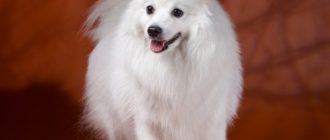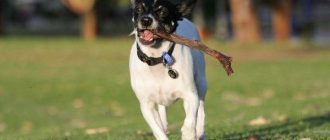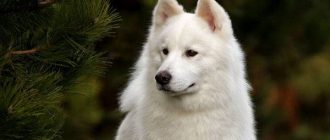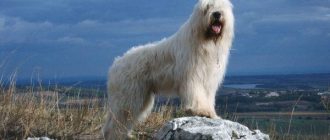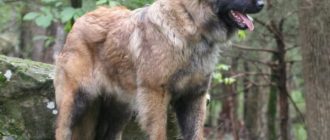Assessment of breed characteristics
Contents
| Adaptability Definition of how easy a dog is. can adapt to changes in life. |  |
| Shedding Level Level and frequency of hair loss in animal. |  |
| Level of tenderness Level and amount of tenderness and affection that the dog gives back in return for attention to itself. |  |
| Need for Exercise Daily Activity Level dogs. |  |
| Social need Required number of dog contacts with other animals as well as people. |  |
| Housing ratio Factor that determines the level of noise and other inconvenience that the dog can deliver to the owners in the ratio the size of the apartment to the size of the dog. |  |
| Grooming Number of bathing, combing, as well as necessary number of professional grooming sessions required the dog. |  |
| Friendliness in an unfamiliar environment society with strangers or in an unfamiliar environment. |  |
| The tendency to bark The tendency to bark and its frequency and volume. |  |
| Health Issues Potential Health Status dogs. |  |
| Territorial tendency of the dog to protect his house, yard or even a car owner. |  |
| Cat friendliness A trend towards cat tolerance and reduced manifestation of hunting instincts. |  |
| Intelligence Dog’s ability to think and solve emerging difficulties (not to be confused with learning!). |  |
| Education and training Level of difficulty in training a dog perform certain actions. |  |
| Friendliness for children Factor determining how much the dog friendly to children, whether she likes to play with them and endure some children’s pranks. |  |
| Game activity The concept is determined by its very name, and, usually found in almost all dogs. |  |
| Observability Dog’s ability to detect presence a stranger in his territory. |  |
| Friendliness for other dogs Dog’s tendency to find common language with other relatives. |  |
Brief description of the breed
Great Dane is one of the most popular breeds. Some they call him a giant among dogs. Really impressive the size of the dog does not leave anyone indifferent, but despite this dog is an affectionate and tender animal, adoring his family and ready to stand up for her at any time. German dogs originally bred for hunting wild boar. With this task the dog coping is not very good. So the breeders stopped their attempts in this direction. Now the Great Dane is an animal with a warm soul that gets along well with both people and others animals.Although the dogs are not distinguished by malice and aggression, nevertheless the impressive size of the Great Dane can scare anyone robber or attacker that often plays into the hands of the owners such pets. The Great Dane descended from mastiff-like dogs, but, unlike other descendants of these dogs, the Great Dane is more elegant. The dog has an athletic, muscular physique. Is different massive head and slightly elongated body. German dog owns an elongated, graceful neck that attaches to the dog special charm. Dog’s ears often stop, but this is not necessary. Everything Depends on the preferences of the owner. The impressive size of the dog is often cause trouble to the owner and his family. Animal can inadvertently pushing decor or interior items. therefore Great Dane is best kept in spacious homes or apartments. Despite its size, the Great Dane is good and affectionate animal. He loves tenderness, affection, loves to play with children. At the same time, I’m always ready to show courage, especially if it’s concerns the protection of the family. Although the Great Dane is soft character, yet the owner of this dog must be given due attention to pet education issues. Best resort to specialist help. Dogs of this breed are always thirsty for desire please the owner, they are trying in every way to please him and the members families. Great Danes experience great happiness when stroking, caress, they are not averse to soak up on the sofa or in the chair master. It is noteworthy that, despite its size, the Great Dane not able to eat a lot of food. Moreover, he doesn’t need a big the yard. The dog will feel comfortable and in a small the courtyard. The main thing is to prevent the possibility of damage to objects interior and decor in the house. Thanks to grace and complaisant character, the Great Dane is extremely popular. On Today, the breed in its popularity takes 24th place among registered by the American Club dog breeding. The sad point is that due to large, great dane has a short duration life: up to 8 years.
Great Dane photo:
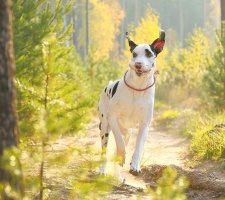

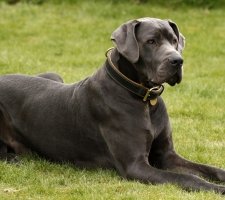

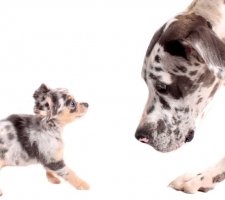
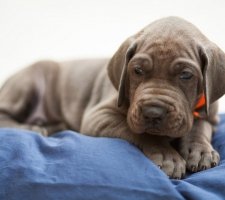
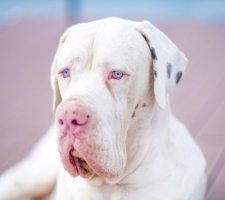
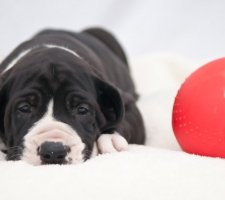
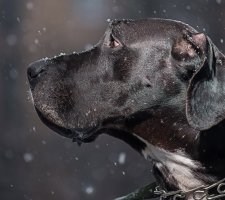 Photo of Great Dane breed dogs |
Photo of Great Dane breed dogs |
Origin history
Figures with images of dogs were discovered during excavations in Egypt. They date back to 3000 BC. Also images these dogs are found in ancient Babylonian temples, period occurrence of which exceeds 2000 BC. Besides of this, there are letters saying that the dogs were kept and in ancient Tibet. These documents are dated 1121 BC Era. It is believed that the breed originated from different breeds of dogs. This happened during the time of the Assyrians, who were actively trading. dogs all over the world. It is believed that the Greeks and Romans crossed dogs with other dogs. There is a pretty plausible opinion that the ancestors of the Great Dane were English mastiff and Irish Wolfhound, as well as Irish Greyhound. for hunting wild boars. Therefore, stopping the ears. This was necessary so that during the fight the boar doesn’t tore the dog’s ears with fangs. In the late 1600s, many German nobles began to keep the dogs in their homes. They began to call their “Kammerhunde” i.e. “domestic dog”. These dogs wore gilded and velvet collars and were a sign of his abundance host. Most researchers argue that a significant contribution to breed development made by German dog breeders. It is thanks to their work managed to achieve harmony and extravagance of the external kind of great dane. In 1880, a conference took place in Berlin dog breeders, in which official authorities also took part. By The results of this meeting, it was decided that these dogs should be officially called “Great Dane.” Shortly afterwards, Germany was founded the first club of lovers of the Great Dane. After Germany began to form such clubs in other countries Europe. It is interesting that Italians, as well as English speakers countries did not initially accept the name “Great Dane.” They called this breed is “Alano”, which means “mastiff”. In Italy today German Great Danes are called “Alano.” In the nineteenth century breed development continued actively. The main focus was on the nature of the animal. The fact is that in those days, the dogs were quite aggressive. Thanks to the hard work of the German dog breeders managed to breed with excellent complaisant character and extremely kind soul. This is exactly what Great Dane.
Great dane character
A well-bred German Great Dane is one of the best dogs, characterized by such traits as good nature, tenderness and affectionateness. This pet loves the family, loves spending time with children. He has an incredible desire to please the owner and everyone family members, making it easy to train. German dog wants to always be where his family is. He is very loves children, including strangers. This dog will rejoice your friends, but only if you are sure that they do not threaten you. Otherwise this pet is ready stand up to your defense.
Maintenance and care
Despite the fact that the dog’s hair is short, it is still molt. You can keep your hair under control with weekly brushing wool with a stiff brush. German Great Danes bathe as far as necessary. Some owners of these dogs prefer resort to the services of professional groomers, who are not only buy a dog, but also cut off its claws. Bathe this big dog quite difficult. Check your pet’s ears regularly infections, inflammations and sulfur pollution. Brush your ears need a special swab soaked in a solution that appointed by the veterinarian. Please note that cleaning the ear canal a cotton swab is not recommended. So that the dog’s mouth clean and did not emit an unpleasant odor, it is necessary weekly brush your pet’s teeth.
Training and training
Great Danes are classified as dogs of average intelligence, but as as a rule, they are very easy to accustom to the toilet, as well as to the execution basic teams. Dogs of this breed have a strong desire to please to your master. Many German mastiffs are particularly successful in obedience, agility and other competitions. The process of socialization Great Dane must be started at an early age, best with 3-6 months. Dog puppies grow very fast, so they even puppies will be relatively large. the year of life of the Great Dane is compared with the first fourteen years the life of an ordinary child. These dogs must be provided due. attention and consistent, systematic training. Correct an approach to this issue will make your dog an excellent pet. Great Dane must not be allowed freely, without supervision move around the house until you are sure that that the puppy knows all the rules of behavior in the house. Otherwise, there is a risk damage to furniture and home decor items. You need to keep in mind that puppies Great Dane are very similar to children. They like to play, nibble everything what comes across. Therefore, it is important to organize the process correctly. learning. Eliminate any manifestation of aggression. Need to learn explain to the dog what is possible and what is not. During training it is better that children do not touch the dog, as this will decompose discipline and adversely affect learning outcomes. Manifest perseverance and self-confidence!
Health and Disease
The average life expectancy of a Great Dane is 7-8 years. The main health problems that can occur in dogs this breed include: bloating, dermatitis, pyoderma, demodicosis, hip dysplasia, cervical instability spine, malformation (Wobbler’s syndrome), inversion of the eyelids, ectropion, congenital idiopathic megaesophagus, congenital deafness, shoulder osteochondrosis, lymphoma, osteosarcoma and dilated cardiomyopathy If any of diseases, you must immediately contact your veterinarian. Timely recourse for help will allow you to deliver on time correct diagnosis and achieve successful treatment. In no case do not self-medicate!

